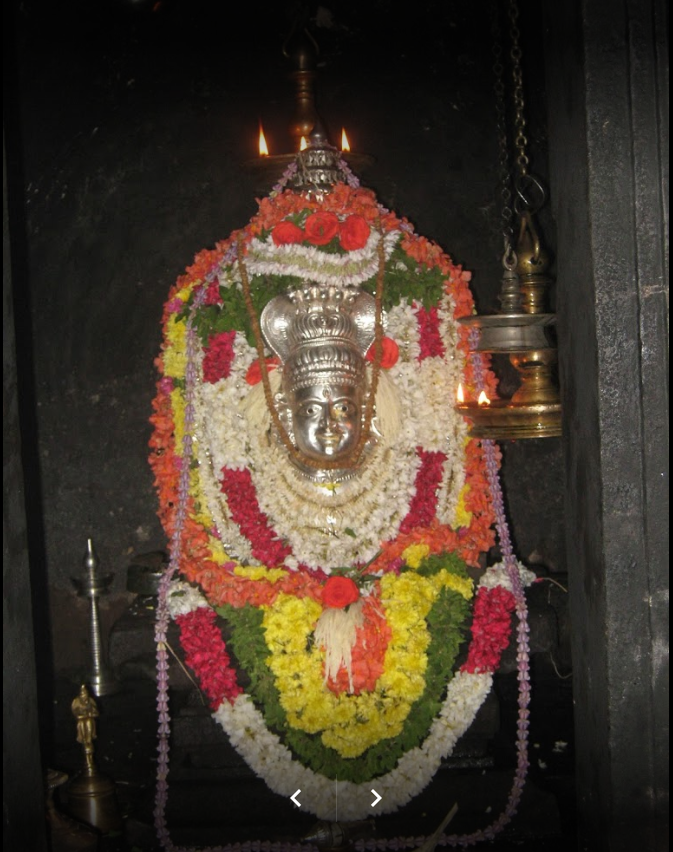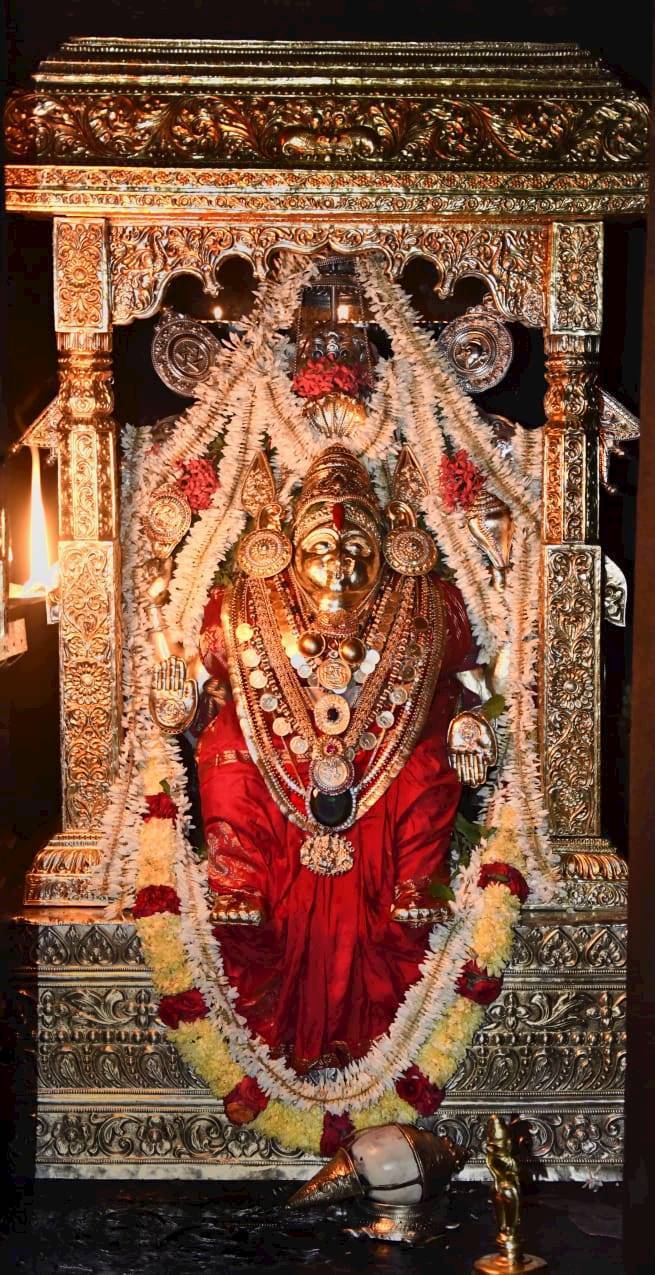About
Shree Rajarajeshwari temple is located at Polali in Kariyangala Village of Bantwal Taluk in Dakshina Kannada District of Karnataka State. Shree Kshetra Polali is in the heart of this village surrounded by high hillocks and wide paddy fields. River Phalguni flows from east on the northern side a furlong way from the temple. It turns left towards south at the back of the temple in the Western side. This place was being called as Pural and the deity in the temple was known as Porala Devi in several old records and ancient epigraphs available.
Puliapura is its Sanskrit version. In Kannada this is called Polali. It is believed that King Suratha got the temple constructed, installed the image and placed his own crown on the head of the image. This is an ancient temple. This temple has been alluded to in the Ashokan inscriptions and in the reports of the foreign travelers who visited India. Queen Chennammaji of Keladi visited Polali and got a grand chariot constructed for the temple.
Being a pilgrimage Centre, Polali attracts travelers and tourists with its natural scenic beauty and serenity. Polali Chendu is a unique festival in this temple, which will be performed during annual festival of the temple.
Mythology (Story From Puranas)
When evil forces gained strength and got the upper hand and embodied themselves as demons and began to destroy the Dharma Setu (Bridge of Dharma). Rajas and Tamas were the most predominant evil qualities in them. They tortured the people in innumerable ways. In such a situation Shree Bhuvaneshwari, Divine Mother assumed divine forms with the names Kumari, Tripura, Kali and Durga and established the age old Dharma by destroying the wicked and protecting the good.
These facts have been explained in Shastras and Puranas. The above were fractional incarnations of Shree Mahadevi just like the incarnations Matsya (fish) and Koorma of Lord Mahavishnu. But Shree Lalitha Devi was the full incarnation of Shree Bhuvaneshwari. After coronation She was called Shree Rajarajeshwari. Her sacred story is as follows:
After the untimely death of his wife Gouri, Lord Rudra renounced all activities and started severe penance. Seeing this Kama the God of Love shot Rudra with his darts of love. Rudra in rage opened his third eye and burnt Kama into ashes. After many years Lord Ganesha made a human form with that ash and placed it before Rudra. Lord Rudra looked at it with compassion and an inert image became a living being. Nandikeshwara initiated him with the holy Rudramanthra. The ash born being repeated the mantra with implicit faith and incessantly prayed Lord Shiva (Rudra). Lord Shiva became highly pleased with him and blessed him with many boons. This being became famous as Bhandasura.
Later, after many years with the advice of Divine sage Narada the destitute Gods engaged themselves in meditation, worship and penance to make the Divine Mother manifest before them. They even got ready to Sacrifice their bodies in the blazing fire of Yajna. Shree Bhuvaneshwari in Manidweepa (Island of gems) saw the sufferings and penance of Gods and appearedbefore them in the bright form of Lalitha Devi, which is the full incarnation of Shree Bhuvaneshwari. Gods of heaven and Thrimurthis built a mahamantapa and a chariot for Shree Bhuvaneshwari with the help of Vishwakarma.
Brahma and other Gods assembled in the Mahamantapa and with just a look at Goddess Shree Mahadevi the things they desired was fulfilled. Goddess boarded her Shree Chakra ornamented with navaparvas. Shree Devi with her large army and assistants advanced in no time and arrived at Shonithapura of Bhandasura and encamped there. The battle raged. Within four days Bhandasura's brothers, nephews, relatives and ministers, army chief and large army died fighting against the army of Shree Mahadevi.
On fifth day Bandasura himself came and fought against Shree Mahadevi and died. All the three worlds again returned to peace and happiness. Shortly afterwards Hari, Hara and Brahma engaged the services of the sculptors Vishwakarma and Maya and got sixteen cities built in the Himalayan region and in other places for the stay of the Divine Mother. All these towns were called Shreenagar and Shree Bhuvaneshwari still lives in these sixteen cities and protects all the worlds from the evil forces.
Installation Of The Image Of Shree Devi
The pious soul who installed and worshipped the clay image of Shree Rajarajeshwari with subordinate deities in the ancient days deserves our greatest gratitude.
It is well known that King Suratha installed and worshiped Shree Rajarajeshwari. Starting from Swayambhuva there are fourteen Manus. In the early years, Swarochisha, the second Manu begot a son by name Chaitra. King Suratha was born in his line after many years. His vast kingdom spread all over the world. Unfortunately by force of circumstances he had to fight with a band of hunters by name 'Kolavidhwamsi'. Even though they were less powerful, King Suratha suffered defeat at their hands. Therefore the King totally withdrew from the areas overrun by his enemies and returned to his capital city.
The Ministers now understood that their King had become weak and incompetent and took the military and treasury under their control. King Suratha now realized that his Ministers had cheated him. He feared that his ministers and military might conspire with his enemies and handover him to them. He therefore decided to flee away for safety. He told them that he was going out for hunting and rode away on his horse. At last he entered a dense forest and reached the hermitage of Sumedha, a great ascetic. The King prostrated before the sage and narrated the event that forced him to come to the forest.
The sage warmly received the King and asked him to stay there for some days. One day Suratha was walking around the hermitage bemoaning the loss of his Kingdom, wealth, wife and children. On the way he met a merchant. He paid his respect to the King and narrated his sad story that how his wife and children driven him away hankering for his wealth. Hearing this story the King took the trader to the sage. Both of them offered obeisance to the Muni (Ascetic). King Suratha then narrated the story of the merchant to the sage. Hearing this sage advised them to worship Divine Mother as prescribed in the Shastras and seek blessing from her.
The King and the merchant offered their obeisance to the sage and took leave of him. Now both of them were eager to see the Divine Mother face to face. At the same time they were will grief - striken because of their attachments to the people who had driven them away. They selected a place from where water had recently receded. This place was not far away from the hermitage of Sage Sumedha.
There, they built a hermitage and there in they made out a clay image of the Divine Mother along with that of her subordinate deities, strictly in accordance with the rules of Tantra Shastra and sculpture. Both of them began repeating the sacred Devi Sooktha, beginning with words, "Namo Devyai Mahadevyai" and invoked Chandika Devi, the one integrated form of Mahakali, Maha lakshmi and Maha Saraswathi into the image they were worshiping. In the beginning they were taking limited food at regular intervals.
Historical Importance Of Polali Temple
It is not easy to clarify the antiquity and importance of Polali Shree Rajarajeshwari Temple with historical evidences. It is said there were many inscriptions here and there around the temple. But, in the past these inscriptions might have been destroyed or taken away due to the indifferent attitude of the persons responsible for their upkeep.
Even then a few inscriptions found at Ammunje, Kariyangala and in Polali Temple are now preserved in the custody of the Karnataka Government. In olden days this Dakshina Kannada District was under the suzerainty of many royal dynasties like Kadamba, Chalukya, Aloopa, Rashtrakoota, Hoisala, Vijayanagara, Ikkeri, Mysore etc. As per history and inscriptions the kings of these dynasties ruled over Dakshina Kannada with the help of the vassals like Banga, Chouta, Ballal etc.
In some administrative divisions called 'Maganes' the kings appointed their own executive officers. They donated agricultural lands to the temples and monasteries under their jurisdiction and did their best to serve the temple deities and set an example to their subjects to become god fearing, religious and righteous. Alupa kings were one of the many royal dynasties that aided and enriched the temples and encouraged temple-worship in our district during their rule from 710-720 A.D.
Daily worship, Special worship, Religious services and Festivals: Daily poojas and special poojas in this temple are done as laid down in Durgagama and Skandagama. The daily morning pooja is regularly done at 8.30 a.m. The noon Mahapooja is daily conducted at 12.30 p.m. and the night pooja takes place at 8.30 p.m. The 'Kartika pooja' and the Flower pooja' offered by the devotees are performed only during the time of the daily poojas and not at other times.
Contact
Shree Kshethra Rajarajeshwari Temple
Address
Polali, Bantwal Tq, Dakshina Kannada District - 574 219, Karnataka – INDIA
Phone
Ph – 0824 2266141
Email
info@polalitemple.com















